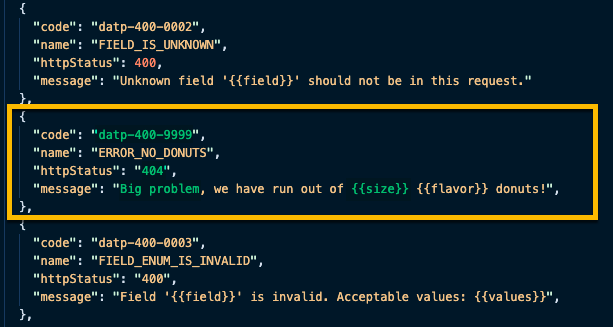# Error messages
DATP provides a few useful functions for generating error messages in multiple languages, and also allowing the DATP error messages to be customized to match your application.
TIP
If your application already uses an i18n or similar solution then you probably don't need to read further. These libraries are optional - use them if you feel they are beneficial, skip them if you don't.
# Objectives
To take the error messages out of the code and put them in JSON files that are easy to translate.
Create libraries of errors for different subsystems. For example, one for DATP, one for you application, and one each for any subsystems you create.
Allow each user to have a preferred language. Error messages are displayed in that language if available, or else in the default language (i.e. English).
# In Use
When you start a DATP transaction you can specify a preferred language. This will usually come from a user database, or whatever other method you have for storing user credentials. In this first example we call a transaction requesting English.

And we receive an English error message in our reply...

If we make the same request specifying Filipino as our preferred language...

...we get this reply...

(For any native Tagalog speakers, I apologise is the translation is wrong!)
# Error libraries
The language files can be either .json or .js files, and get registered at application startup. In these files we specify the following:
- An application 'scope' that prevents name collisions with other error libraries.
- The language of the error library.
- A short description.
For each error we then define:
- A unique error code. It doesn't matter what this is - it just provides a language independant code that can be easily quoted when errors are reported.
- An easy to remember name for the error, that can be used in the code when
generating this error. - An http status, for cases where the error is returned over http.
- The message in the specified language, optionally containing field replacements.
Here are a couple of snippets from errors-datp-EN.js and errors-datp-FIL.js. Note that these could also be a JSON files if you remove the export statements.


Error libraries are registered in the code prior to starting your application server.
import { generateErrorByName, registerErrorLibrary } from './lib/errorCodes'
import errors_datp_EN from './lib/errors-datp-EN'
import errors_datp_FIL from './lib/errors-datp-FIL'
...
// Register our DATP error codes
registerErrorLibrary(errors_datp_EN)
registerErrorLibrary(errors_datp_FIL)
...
// Start the server...
...
2
3
4
5
6
7
8
9
10
# Translating
Translations can be done by a non-technical person, bu editing the JSON error library files (instead of code). Just give them a copy of the default version of the file and ask them to replace the English with the new language, then register their new library before server startup.
# Generating errors
Error messages are generated in application code using DATP.generateErrorByName.
const { httpStatus, message } = DATP.generateErrorByName(
'FIELD_IS_REQUIRED',
{ field: 'data' },
preferredLanguage)
2
3
4
The FIELD_IS_REQUIRED is an application defined error name. You can create as
many error names as you wish - they are just treated as unique strings with
no particular meaning.
Any number of data values can be provided, and are substituted into the error message wherever the pattern {{fieldname}} is found in the message retreived from the error library.
# During Development
We've included a feature that we've found streamlines development.
While a developer is concentrating on writing application code, they can refer to errors that are not defined in the error library yet, and put an example message that can be replaced later.
const error = DATP.generateErrorByName('ERROR_NO_DONUTS',
{ flavor: 'cherry', size: 'large'},
preferredLanguage,
'Emergency, we have run out of {{flavor}} donuts!')
console.log(`error=`, error)
2
3
4
5
6
The optional last parameter, the "Emergency....donuts" message, is used as the error message only until the error is properly added to the error library. In the mean time the developer can concentrate on writing and testing the application.
When it is initially used it will return the following error object, which has the wrong error code and status, and possibly a wrong message, but will suffice because the code is still under development.

At some stage these errors will need to be added to the error library. To make sure that is not overlooked, and to make it easy, a code snippet is written to the console every time it is run, until the error is added to the error library.
Error 'ERROR_NO_DONUTS' was not found in any of the error libraries.
Please edit the following JSON snippet and add it to your error library:{
"code": "ERROR_NO_DONUTS",
"name": "ERROR_NO_DONUTS",
"httpStatus": "400",
"message": "Emergency, we have run out of donuts! - ",
}
At a convenient time, we can cut and paste that snippet and any other errors from the log file or javascript console and append them to our errors JSON file.
In the exampole below it has been added to the error library with updated details - given an error code and an httpStatus, and changed the error message to include the size of the donut.

It now generates the desired error message...

